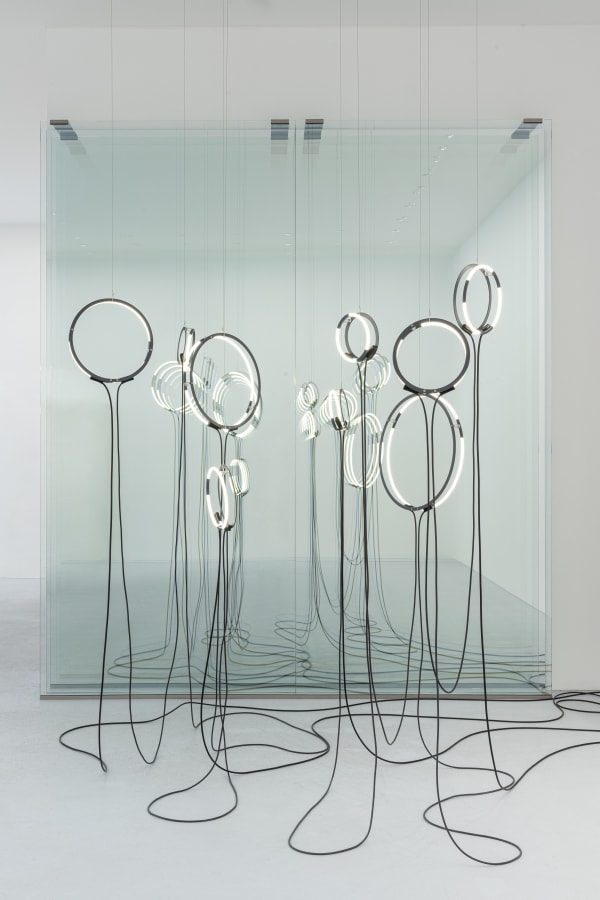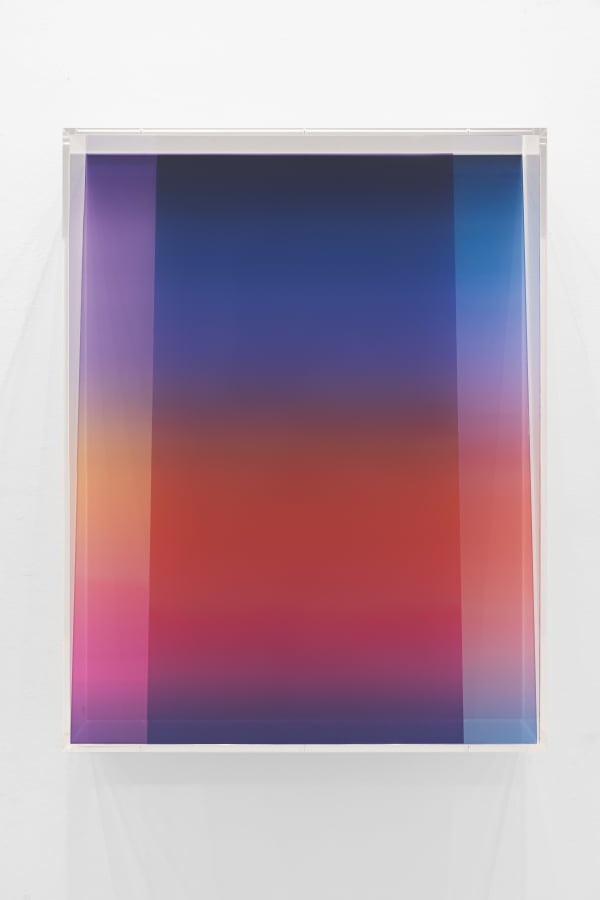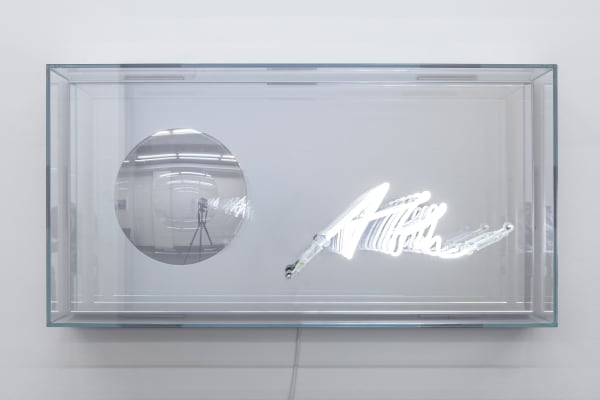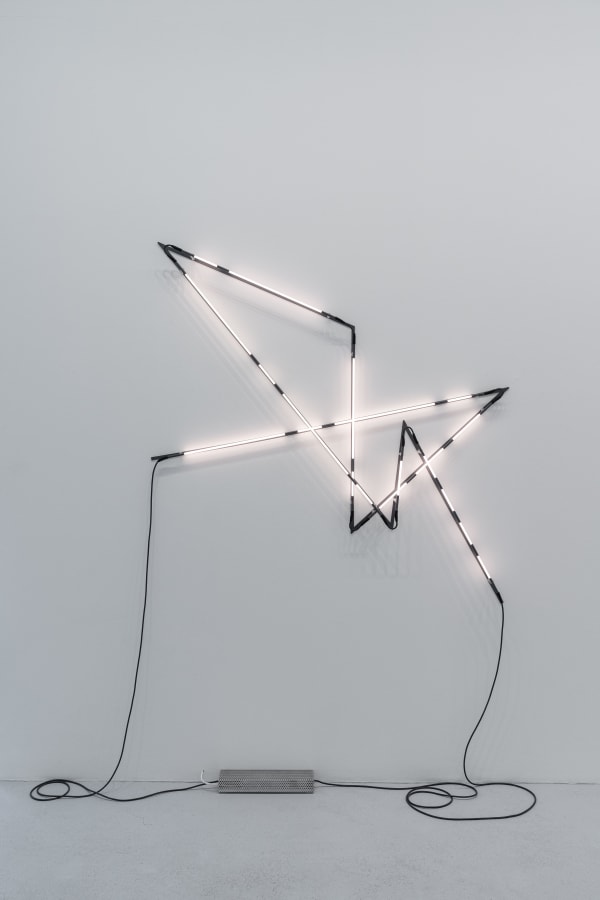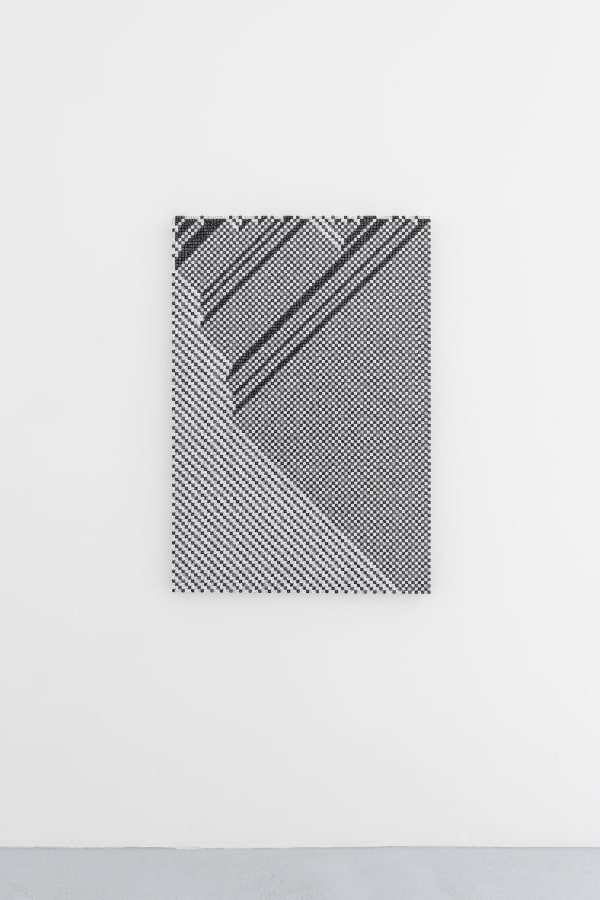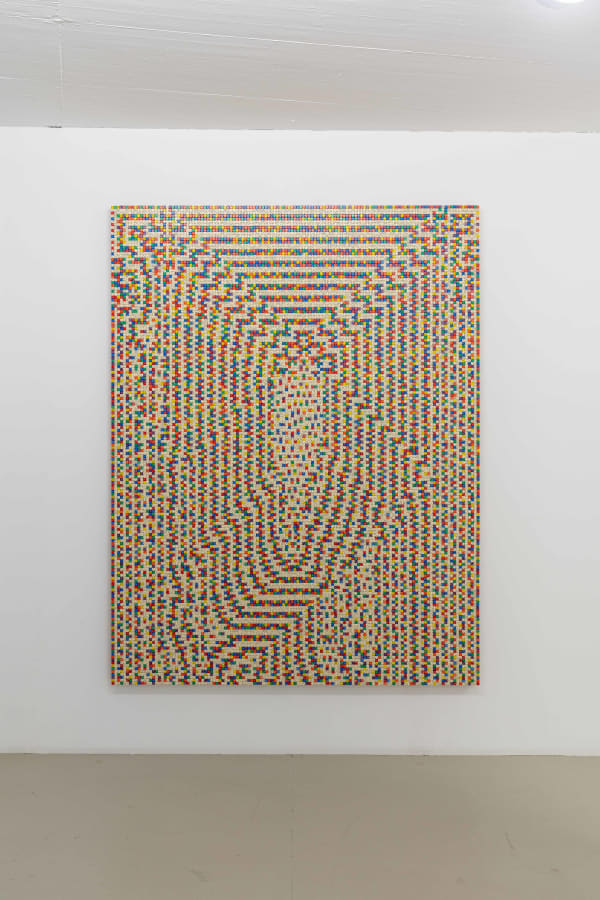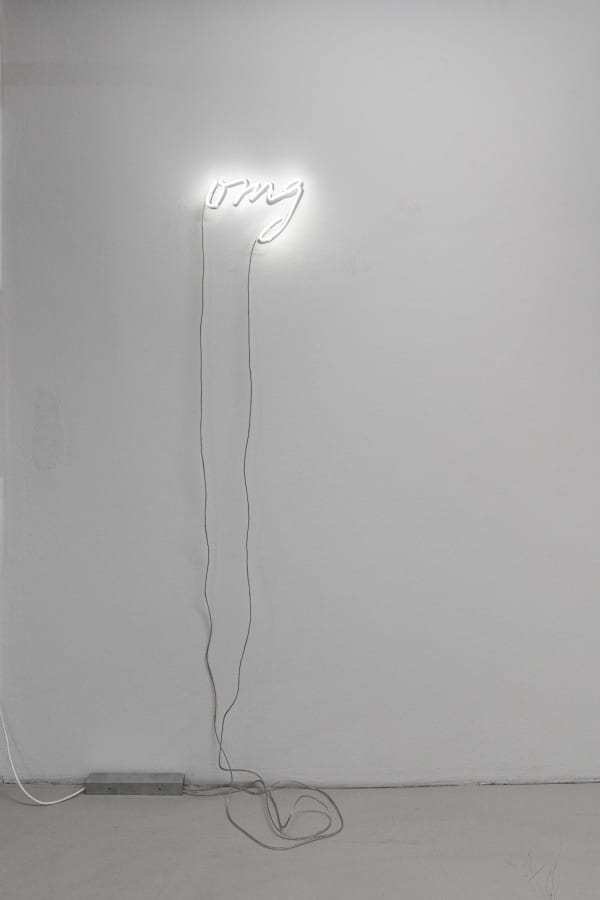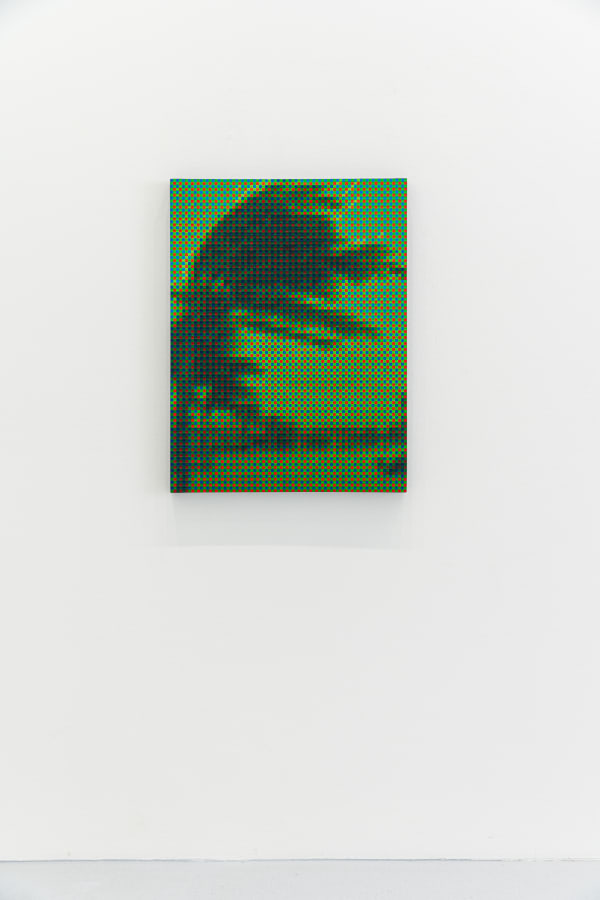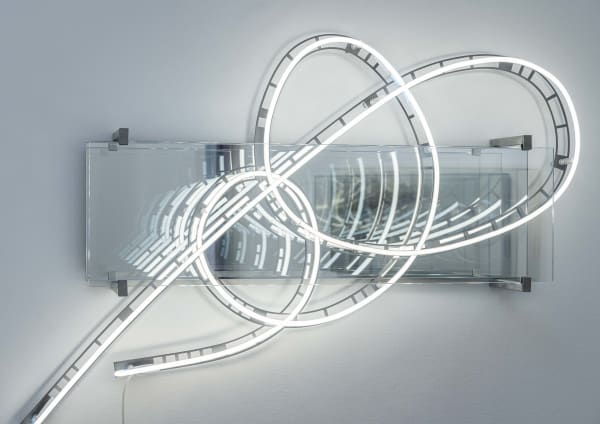
Poetics of reality (encoded) brings together for the first time the works of Brigitte Kowanz and the artist collective Troika, expressing through dialogue their experimental approaches to human perception and the transmission and mediation of information.This Viewing Room focuses on the works of the exhibition within the broader themes of perception and space, language and codes, and politics and change.
Through these chapters thematic connections between the two positions are traced, opening up a multifaceted insight into Brigitte Kowanz' and Troika's work. Clicking on the photos of the works opens up additional information, further photos and texts on the works.
Exhibition view | Poetics of reality (encoded) | brigitte kowanz and troika | Photo: Dirk Tacke
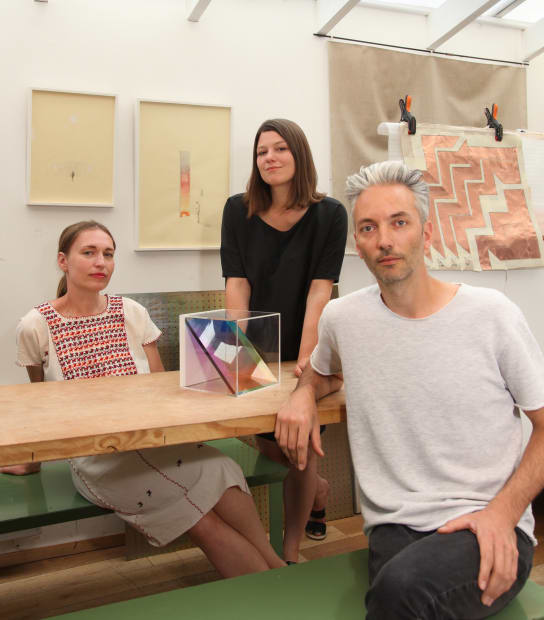
Troika is a collaborative art group founded in 2003 by Eva Rucki (*1976, Germany), Conny Freyer (*1976, Germany), and Sebastien Noel (*1977, France). The artists live and work in London. With a particular interest in subjective and objective readings of reality and various relationships involving humans and technology, Troika examines how information is transmitted in the digital world and how it transitions into physical reality. Their works deal with different systems of representation and illustrate how technological progress and human reality influence each other.
"By creating work based around the idea of a multi-facetted truth whereby opposites can co-exist in the same space this idea might come to the fore. Working as a collective has contributed to our understanding that reality is a very personal matter." – Troika
Troika (2018) | Photo: Studio Troika

The Austrian artist Brigitte Kowanz (1957-2022) made light her primary artistic medium. She continuously examined its different qualities and manifestations via objects, installations, and spatial interventions using various illuminants. The medium of light is made tangible and treated as an independent phenomenon, material, and information carrier, as well as a metaphor for a search for new forms of representation of visible reality. Kowanz combines language – for instance political statements and news transmissions – with formal aesthetics, illustrating that light is not just a neutral vehicle for information, but plays a decisive role in shaping it.
"Light is a fascinating material - it is the basis of all visibility and understanding, light is the basis of life and light is information." – Brigitte Kowanz
Brigitte Kowanz (2020) | Photo: Mato Johannik

Brigitte Kowanz‘ installation Relations (2021) consists of nine white neon light rings with inscribed Morse codes, which seemingly float in front of a large-format mirror-glass wall. Referring to the nine letters of the title of the work Relations, each of the nine individual rings represents a letter in Morse Code. The light segments connect with each other in a self-referential manner, with the size and diameter of the rings predetermined by the letters. Cables run between them and the floor like a three-dimensional drawing, serving as a metaphor for connection and networking.
The mirror wall acts as a multiplier and reproduces the circles of light into infinity: Relations is essentially characterized by this spatial expansion, in which the real space meets and connects with virtual, mirrored spaces. This creates "transitions, transformations and reflections of reflections, nested spaces with their own openings", in which viewers are challenged to participate by their won reflection and become a further element of a seemingly limitless installation.
Photo: Dirk Tacke

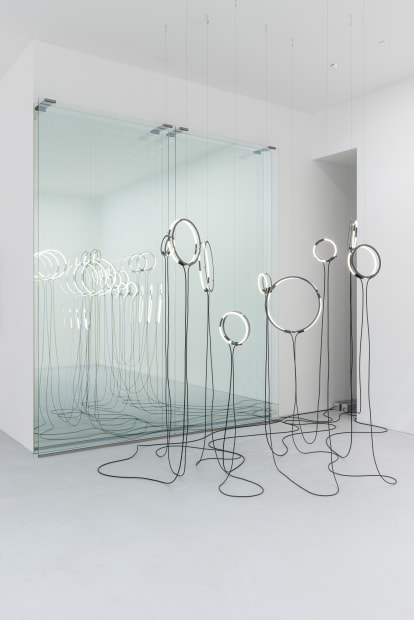


– Brigitte Kowanz
Photo: Dirk Tacke

In Borrowed Light (2020), photographic film strips, previously exposed to a colored laser, are diagonally fixed to the front and back of an acrylic plate within a transparent acrylic box. In the plate’s center, two exposed film strips of different color gradients overlap, intensifying their effect.
From both sides, a flow of intense color fields emerges, comparable to abstract photography. The work is reminiscent of a sunrise or sunset, with the entire color spectrum representing this natural phenomenon. The sunset is one of the most frequently recorded and reproduced photographic motifs, revealing the attempt to digitally capture a profoundly ephemeral event. Troika combines analogue and digital techniques in their production processes, in order to work with intangible and ephemeral media such as light; to shape their reception as something malleable rather than absolute. The artists expand the two-dimensional image onto a three-dimensional object and explore how technology is changing the human relationship to reality and how the digital world is increasingly extending into the physical world.
Photo: Dirk Tacke
Installation View Borrowed Light (2018), Barbican Center, London (2018-2019) | Photo: Studio Troika
Troika, Borrowed Light (2018)
Video of the installation at Barbican Center, London (2018-2019)
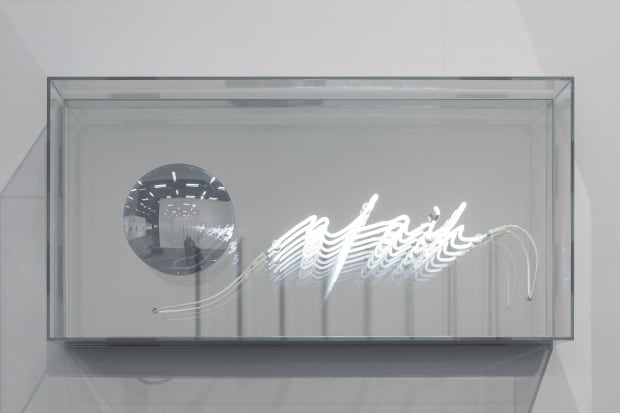
Permanent Installation In vivo - In vitro (2006), Max-Planck-Institute, Münster (2006) | Photo: Steffan Sturm

Brigitte Kowanz‘ new series Acronyms (2020) illustrates how the progress of digitization is also changing our language. In the artist's own handwriting, common abbreviations of English idioms in everyday digital exchange such as tbh (to be honest), afaik (as far as I know), or omg (oh my god) are depicted in neon letters.
The neon texts are handwritten and bring, on the one hand, a graphic element with its own rhythm to the works. On the other hand, the acronyms are even further coded, as the handwritten texts are not clearly decipherable. The acronyms symbolize the speed and internationality of today's communication.
In the two works tbh and afaik (both 2020), Brigitte Kowanz expands the level of translation and transformation of language through a further process and the inclusion of the viewer in the works of art. The two letterings are embedded within a mirrored, glass showcase, through which the writing is reproduced into infinity. At the same time, the viewer is included in the work of art through a convex mirror lens and can see himself and his own immediate surroundings interwoven with the writing. For Kowanz, "mirrors, as a material for artistic work, enable recipients to be included, to let them become part of the work and to create virtual spaces."
Photo: Peter Hoiss

"We are interested in systems and models that we as humans set up to create order, sense, purpose and stability. These systems can be religious, scientific or whatever, but people often mistake these models for reality. We’re fascinated by how these models become the status quo; the ultimate truth, even though they are just models that we set up to eliminate uncertainty."
– Troika
Photo: Studio Troika
Installation view Negative Space. Trajectories of Sculpture, ZKM Center for Art and Media Karlsruhe (2019) | Photo: Studio Troika

The wall work Unstable Construct (2021) shows a color field on photographic film strips, the color of which varies in relation to the viewer’s perspective. The shape is reminiscent of an architectural column, the surface of which fluctuates with the change of location and evolves into a spectrum of color. Through the use of colored light mirroring the digital RGB color space, analog and digital components come together during implementation. Troika's interest in the superimpositions and entanglements of the physical and virtual world becomes clear here. They question reception habits and demand active perception in real spacetime. They indicate that most of our everyday actions, interactions or decisions are in one way or another controlled, changed, supported or promoted by technology. The work shows how alterable and dependent reality is on one’s own perspective: that even an apparently tangible object such as a column can be put in question.
Photo: Dirk Tacke
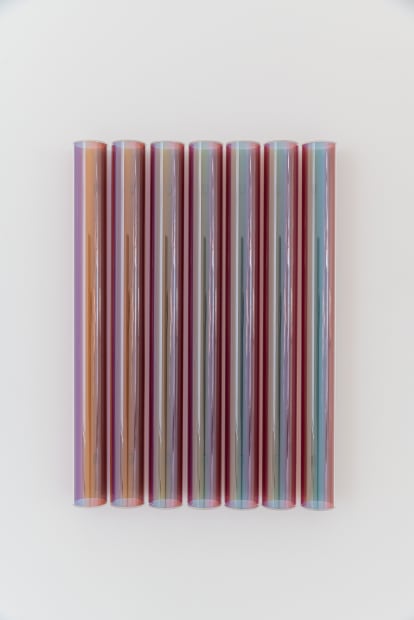
"The colour gradient on the film are achieved by exposing the photographic emulsion of the transparent film to red, green and blue coloured lasers. It is the same colour system native to the computer. The colour gradients, precisely created within the digital environment, are thus transferred to the analogue films, physically manifesting the computer logic. The result is this unstable object, which hue constantly shifts, and whose diaphanous physicality oscillates between solid and gaseous. An aesthetic were digital and physical worlds collide, overlap and inform each other. A world not merely seen through, but now also built in RGB."
– Troika
Photo: Dirk Tacke
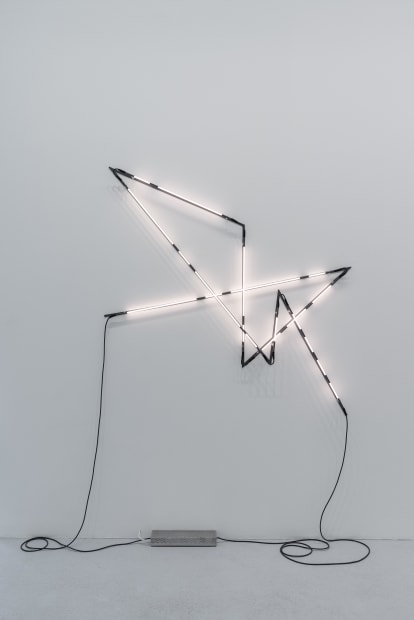
In her light sculpture Chances from the Networks series (2020), the Austrian artist visualizes the complex relationship between seeing, reading, understanding, perceiving and recognizing. She utilizes Morse code, inscribed on the fluorescent tubes. The linkage between language and light is paramount in this work: the segmentation and length of the neon tubes arise from the syntax of the work title - here Chances - transferred into binary code: each tube representing a letter in Morse code. The linearity and logic of the structure is interrupted by the actual creation, which is determined by chance. By dropping the miniature models, the lined up and connected parts in true-to-scale length, the shape of the work, subsequently transferred into neon, emerges. Kowanz invokes a technique by Marcel Duchamp, who established chance as an aesthetic principle in art with his work 3 Stoppages Étalon (1913/14). The black cables are not only technical aids, but also room drawings, spread out on the floor to emphasize the connection between language, light and technology.
Photo: Dirk Tacke





Morse code is an early binary code made up of only two elements: short - long, on - off, which can be utilized to communicate even complex messages. Brigitte Kowanz utilizes Morse code - or the transmission of language into light and sound - as a formal element as well as a carrier of a second level of meaning, in which her interest in the communication, transmission and translation of language and codes is reflected. Brigitte Kowanz has been combining light with characters and linguistic codes since the late 1980s to visualize the complex relationship between seeing and understanding, perceiving and recognizing. Light is simultaneously material and information carrier, which not only illuminates, but also generates meaning as an independent phenomenon, similar to language and writing.
Photo: Dirk Tacke
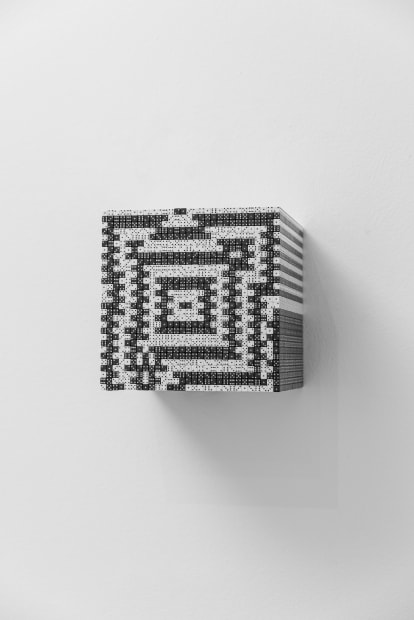
Reality is Not Always Probable (2021) is a cubic wall object, composed of thousands of black and white dice. By manually imitating a binary computer program, the elemental arrangement is determined by the base color of the dice. The front shows an intricate pattern, while the repetitive dice on the sides create the impression of the object extending endlessly into space. Troika is interested in questioning the effects of digital measurements and scientific assessments in society and real life. At the same time, they also point out that our everyday actions are shaped by digital technologies. The algorithm of Reality is Not Always Probable is based on the system of the cellular automaton, which is also used to simulate social growth. The calculated placement of the cubes is antagonistic to their symbolic power of chance and shows that reality remains incalculable - at least in part - despite increased control by digital technologies.
Photo: Dirk Tacke
Installation View, Cartography of Control, Kohn Gallery, Los Angeles (2015) | Photo: Studio Troika

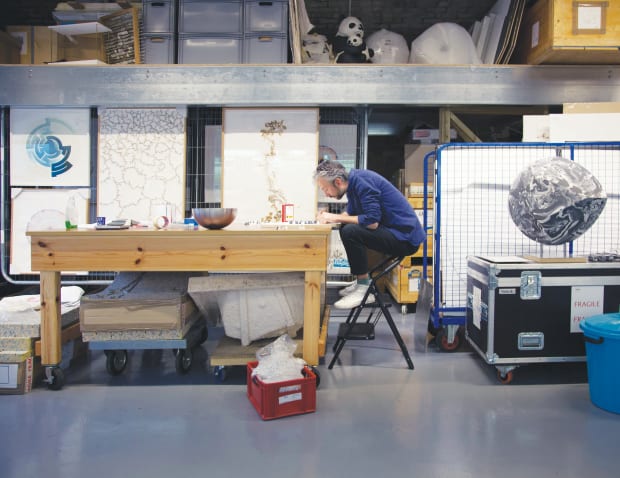
"The dice are used to reference our traditional relationship with fate and chance, while the algorithms are an expression of a rapid technological and societal change, that has made them a powerful tool to both simulate and predict our everyday reality."
– Troika
Photo: Studio Troika

Reality is Not Always Probable (2019) is a wall object with a lopsided wave-shaped pattern, a result of thousands of colored dice stacked upon and beside one another. Based on Troika's interest in the relationship between chance and control, the work represents the materialization of a computer simulation. The algorithm, which is based on the model of the cellular automaton, generates random systems, the starting point of which is determined by Troika. The order of dice in each row determines that of the next, creating complex sequences that are based on the binary principle of color and non-color. Troika's dice works refer to the historical use of dice as a means of determining fate, chance and luck. The roll of the dice is based in the laws of probability to which the process of the algorithm runs contrary. It is autonomous and can exist independently to everyday life, while reality itself is increasingly influenced by computer-based systems. The work clarifies Troika's investigations into showing how new technologies permeate physical reality and individual perception.
Photo: Dirk Tacke

As part of her exhibition in the Austrian Pavilion at the 57th Venice Biennale in 2017, Brigitte Kowanz showed a series of works explicitly dedicated to the topic of digitization. In her work Email 02.08.1984 03.08.1984 (2020) Morse code can be found in a transformed form, in that the date of sending the first e-mail appears on an iPad as a light- and acoustic signal.
The neon yellow cable - alluding to the neon tubes that Brigitte Kowanz utilizes in her works - forms a curved floor drawing communicating the same date that can be found in written Morse code.
Brigitte Kowanz makes the following statement about these new works: “The initial focus of the discussion was on data, codes and light as information. Until now, I had worked on the origins of information transmission with light (electromagnetic waves) - the Morse code - but now my interest is directed towards the present, digitization, the Internet - the digital society. Light is not only the basis of all life, it is also the basis of post-analog communication."
Photo: Dirk Tacke
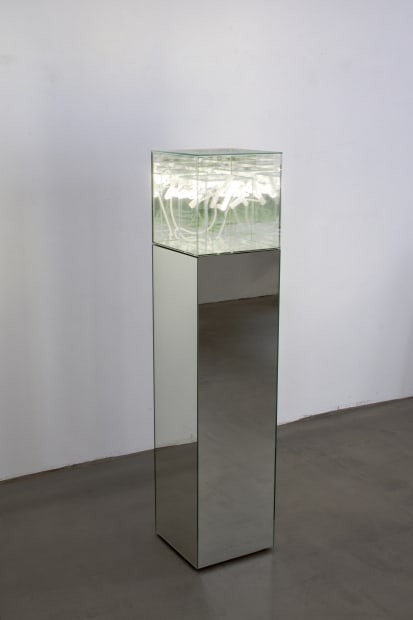
Mindfulness (2020) is a work from Brigitte Kowanz’ series of installation cubes for indoor and outdoor spaces, designed as small mirror cabinets for the eye. The title of the work is repeated, superimposed and condensed in neon letters, creating a visual pull that takes the viewer into metaphysical spheres. The cube merges with its surroundings through the reflections and includes the viewer and the room via the mirrored base.
Photo: Studio Kowanz
Installation view Lost under the Surface, Haus Konstruktiv, Zurich (2020) | Photo: Stefan Altenburger

- Brigitte Kowanz
Photo: Dirk Tacke
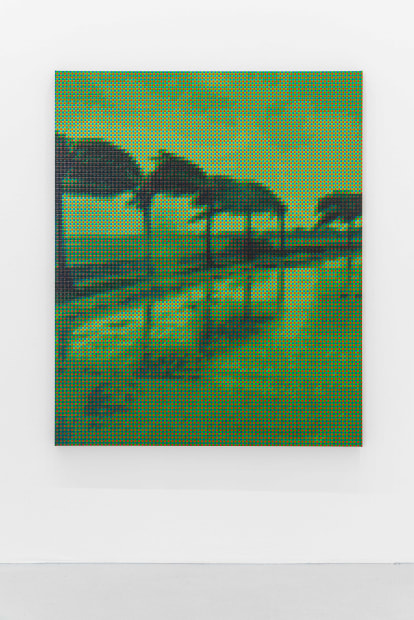
Troika's series Irma Watched Over by Machines (2019-2020) shows recordings of surveillance cameras during Hurricane Irma, with records highs in wind speed and strength, in 2017. The artists transfer the visual recordings with the original RGB color spectrum of the digital image sensors onto canvas. In order to produce the color of the enlarged pixels from 16 red, green and blue tones, they implement an algorithm that calculates or interpolates the exact color information with neighboring brightness values in such raster graphics. The works juxtapose the devastating effects of a natural disaster with the neutral eye and merciless logic of artificial intelligence. The appropriation of algorithm functions in the artistic process can be understood as an expression of rapid technological and associated social change, which Troika reflects upon in their works.
Photo: Dirk Tacke

"The paintings present images of hurricanes captured by outdoor networked cameras, and are painted, in the raw bayer pattern that both the cameras and the computers record and see. The world in red, green and blue, has seen by a nascent sentient AI. The brute force of the weather mirrored in the brute logic of the machine."
– Troika
Photo: Dirk Tacke
Studio view Irma Watched Over by Machines, Studio Troika, London | Photo: Studio Troika
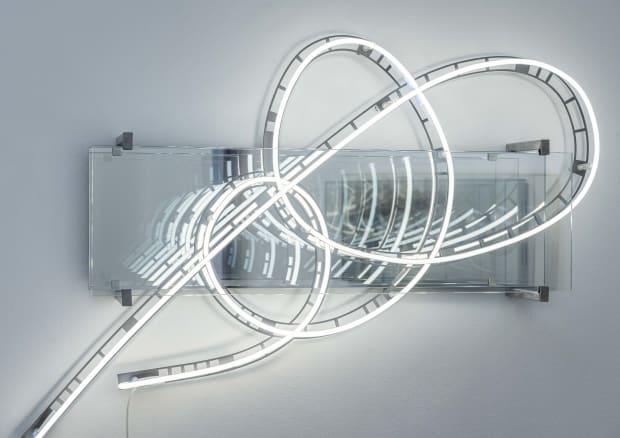
Brigitte Kowanz‘ work with the title UN Climate Change Conference Paris 30.11.2015 12.12.2015 (2019) alludes to the dates of the Paris Climate Agreement, which obliges all signing parties to limit human-induced global warming. In Morse code, the artist has inscribed these significant dates of negotiations onto the spiral-shaped curved fluorescent tubes, which are both a testimony to contemporary European history and a reminder of the global responsibility of each individual. In other works from the Codes and Cables series, such as World Wide Web 12.03.1989 06.08.1991 (2017) or Email 02.08.1984 03.08.1984 (2020), Kowanz immortalized the milestones of political unification and digital revolution, as well as the caesura of our present, which have brought about much social and political upheaval. The UN Climate Change Conference Paris 30.11.2015 12.12.2015 (2019) differs from these works with its more open approach to neon and space. The neon tubes transcend the boundaries of the glass and mirror showcase into the real space, thus opening up new entanglements between reflections, light, space and the viewer. Kowanz describes her interest in this as follows: "The viewers are confronted with themselves in the reflection while standing inside the object. It is more than a typical mirror image. In these works, viewers find themselves in virtually generated rooms in which I try to confront them with philosophy, language, and acute socio-political issues. This is an important phenomenon and is accompanied by aspects of natural science. The observation and presence of light is actually very elementary, something that everyone can experience day by day."
Photo: Dirk Tacke
Installation view Infinity and Beyond
Austrian Pavilion, 57th Venice Biennale (2017)
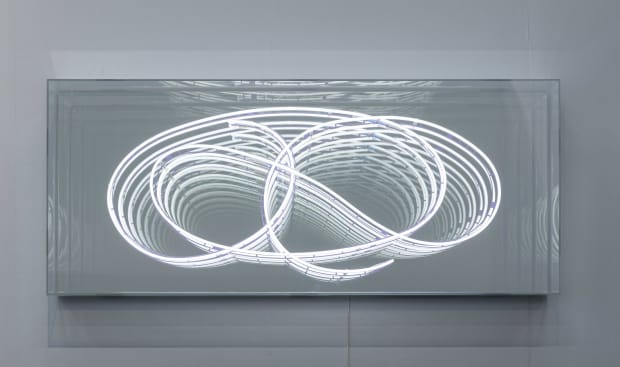
– Peter Weibel, Messenger of Light, Venice Biennale Catalog (2017)
Brigitte Kowanz, Artist's Practice
Video for the Austrian Pavilion at 57th Venice Biennale (2017)

Brigitte Kowanz was awarded the Großer Österreichischen Staatspreis (Grand Austrian State Prize) in 2009 and exhibited at the Austrian Pavilion at the 57th Venice Biennale (2017). She has held a professorship at the University of Applied Arts in Vienna from 1997-2021. Selected solo exhibitions have taken place in the Museum Haus Konstruktiv, Zurich (2020), Taxispalais, Innsbruck (2011), and the Museum of Modern Art Foundation Ludwig, Vienna (2010).
→ to the artist's page
Photo: APA | Georg Hochmuth

Selected solo exhibitions of Troika have been presented at Barbican Gallery, London (2019), NC Arte, Bogotá (2015), and the Daelim Museum, Seoul (2014). Troika’s cross-media works are part of the collections of the Center Pompidou, Paris; M+, Hong Kong; the Victoria & Albert Museum, London; the Art Institute of Chicago; the Museum of Modern Art, New York; Jumex Collection, Mexico City; and the Eretz Israel Museum, Tel Aviv. Troika realized three site-specific installations for the British Pavilion at World Exhibition 2010 Shanghai.
→ to the artist's page
Photo: Studio Troika

For more information on the exhibition poetics of reality (encoded) including an exhibition video, please click here.
The exhibition is curated by Madeleine Freund, created in collaboration with galería OMR, Mexico City and supported by NEUSTART KULTUR of Stiftung Kunstfonds.
→ to the exhibition text by Madeleine Freund
